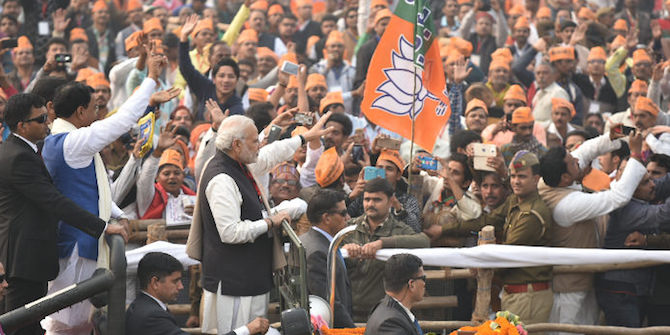 Last month a 26 year old Dalit PhD student at the University of Hyderabad took his own life following an unjust indictment from the administration. Amal Shahid writes that despite a progressive constitution and policies to support lower caste access to higher education, the Rohith Vemula case highlights that even the students who do make it to university still face severe discrimination which seriously undermines their full and equal participation.
Last month a 26 year old Dalit PhD student at the University of Hyderabad took his own life following an unjust indictment from the administration. Amal Shahid writes that despite a progressive constitution and policies to support lower caste access to higher education, the Rohith Vemula case highlights that even the students who do make it to university still face severe discrimination which seriously undermines their full and equal participation.
Caste in India is an age-old system that creates barriers to self actualisation among sections of the population based on imagined social divisions. The system has evolved over the centuries but persists even today. Set in a neo-liberal economy, it is now characterised by discrimination in a new milieu of changed social realities. This changed socio-economic environment is partly a result of B.R Ambedkar’s contribution to the Indian Constitution, a progressive social document which insists that no citizen should be discriminated against on the basis of caste. As the sole representative of the Dalits (untouchables) during the framing of the constitution, Ambedkar embodied Dalit aspirations and played a great role in empowering them through his writing, campaigning and as a politician. His policies have gradually led to a curtailment of the prevailing rigid social structure and have ameliorated those hitherto excluded. The most important policy is the reservation system which is an affirmative action by the Indian government to assimilate the backward community into main stream society by providing them with equal opportunities.
Although it still remains an aspiration for most Dalits to secure higher education in foreign institutions, over time it has become easier to obtain higher education in India itself. The literacy rates among Scheduled Castes and Tribes have increased significantly over the past two decades, and so has their share in access to higher education. Given the extent of casteism in India, it is significant to see Dalits competing and at times outperforming students from non-Dalit communities.
However, this has created an illusion among the upper castes of ‘encroachment’ of opportunities by the minority communities, which, in turn, has created a parallel discourse – one of majority victimisation. In a scenario when minorities are able to access opportunities that they were earlier barred from, particularly through the system of reservation, it increases competition and, thus, creates resentment among those accustomed to exclusivity in those fields. Those who fail to understand the complexities of meritocracy and social mobility also fail to recognise the dignity of marginalised.
An obvious consequence of this difference of opinion is social conflict, which is becoming increasingly visible in higher educational institutions in India. These opposing discourses find their expression in study circles as well as in student’s unions functioning vibrantly in universities across the country. These student groups tend to reflect the backgrounds of its members and, hence, have come to represent the views of different social classes.
The existing antagonism between the polarised groups has been made worse through government intervention in the functioning of higher education. The current government has been criticised for attempting to alter school curricula as well as proposing to do away with non-NET scholarships in higher education. But it has faced most flak for appointing undeserving candidates to important positions in universities. It started with the appointment of Gajendra Chauhan as the Chairman of Film and Television Institute of India, who, as per claims of the protesting students, received the unmerited position solely due to his political connections. The problem has now come to a head with the horrific case of Rohith Vemula.
Rohith Vemula, a 26 year old Dalit PhD student at the University of Hyderabad, committed suicide on 17 January 2016. Following unjust indictment from the administration, Rohith, along with four other students, had been prohibited from entering public spaces and was evicted from his hostel. Additionally, the authorities also stopped his fellowship of Rs.25000 per month, part of which he had been sending home to support his family. After days of protest and hunger strikes, Rohith hanged himself.
While the suicide note did not blame anyone, the complex underpinnings of the matter cannot be ignored, and over the last month the case has become murkier, drawing in politics, caste and resulting in protests in universities across India. The chain of events began in July 2015 when the Ambedkar Students’ Association (ASA), an on-campus group for lower caste students, clashed with the Akhil Bharatiya Vidyarthi Parishad (ABVP), the BJP’s student wing, following ASA’s protests against the hanging of Yakub Memon. After the dispute, ABVP accused five students of assaulting its President, who they claimed had to undergo an operation due to the physical trauma he endured. However, reports suggest that the operation was in fact for appendicitis. What is more, the inquiry commission set up to probe the issue absolved the five students of wrongdoing. Yet after the appointment of a new chancellor by the government, P Appa Rao Podile, the students were indicted. It was later indicated that Bandaru Dattatreya, a BJP minister in Telangana, had written to the HRD minister to ensure action against the offenders.
This shows that instances of social exclusion have a far deeper impact than is usually assumed. Against a narrative of failure associated with Dalit communities, Rohith had surmounted barriers of inequality to attain the dignity of being a deserving scholar. Yet Rohith’s letter to the Chancellor prior to his suicide demonstrates the anger against exclusion and discrimination he continued to face: “Please serve 10 mg of Sodium Azide to all Dalit students at the time of admission…Supply a nice rope to the rooms of all Dalit students.” His suicide letter is also indicative of the oft-neglected plight of Dalit students and the barriers they face in higher educational institutes.
Discrimination in higher educational institutions is not confined to students’ unions but extends to the classroom as well. Dalit students are made to feel inferior not only due to their differing opinions, but are also frequently reminded of their caste. There is a misbelief that Dalits have easy access to facilities due to reservation. The upper castes impose their superiority in terms of acquiring opportunities through the General quota, which seems to have become a misnomer for being more deserving. It results in a unique kind of segregation, both within the classroom and outside of it. And those who decide to speak against this are openly branded as ‘casteist’ and ‘anti-nationalist.’ Therefore, socio-economic inclusion has not been complemented with a psychological inclusion.
Another issue is that although higher education may have become more accessible, there is a lack of ‘good’ education. There has been a precarious rise of private institutes instead of public universities in recent years. Private institutions are known for exacting high fees, often have poor infrastructure and provide little financial assistance. On January 23, three female students of SVS Yoga Medical College at Kallakurichi in Tamil Nadu also committed suicide due to resentment against the demands by the institute. Therefore, discrimination in the quality of education further aggravates the problem in expanding Dalit access to higher education.
Recent events show that there has been a lamentable persistence of what I call institutional ‘casteism’. Inequalities persist in India as everywhere else, not just economically, but also socially. Casteism in India, however, is a peculiar form of division which is bound to have consequences. History is witness to instances when prolonged inequality and the frustration that arises from it often leads to civil unrest. Thus, policies of provisions and access must be accompanied by wider social acceptance, recognition and efforts to overcome psychological barriers.
Cover image credit: counterview.net
This article gives the views of the author, and not the position of the South Asia @ LSE blog, nor of the London School of Economics. Please read our comments policy before posting.
About the Author
 Amal Shahid is pursuing her Masters degree in Economic History (Research). She has an undergraduate degree in History from Sri Venkateswara College, University of Delhi. Currently, she is researching migration and labour history of colonial and post colonial India.
Amal Shahid is pursuing her Masters degree in Economic History (Research). She has an undergraduate degree in History from Sri Venkateswara College, University of Delhi. Currently, she is researching migration and labour history of colonial and post colonial India.







